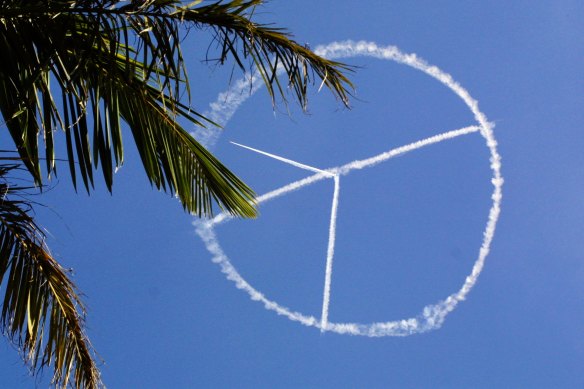
New York: The signs and symbols that designate our beliefs and affiliations are slippery. While the Christian cross, the Islamic star and crescent, the Jewish Star of David and their copyrighted, vigorously litigated corporate equivalent swooshes, apples and targets, may prove resilient, a dizzying mix of familiar and newly minted graphic devices now compete for our dwindling attention.
These days there is no movement without messaging. Even anarchy has a brand identity; its scratchy circled A logo has migrated from the corner lamppost to a pair of Converse Chuck Taylor Anarchy-edition All-Stars. From the pink hats of the Women’s March to the red hats of the Capitol raid, rainbows to thin blue lines, salute emoji to watermelon emoji, we are navigating a thicket of improvised graphic devices.
Then there is the peace sign. Originally devised in the late 1950s by activist-designer Gerald Holtom as a symbol for the British anti-nuclear proliferation movement, the ubiquitous divided circle mark – derived by overlapping the flag-semaphore signals for the letters N and D to stand for nuclear disarmament – itself quickly proliferated as an open-source logo for global anti-war and counterculture movements.

Used plastic containers are fashioned into a peace sign by spectators near the north stage at the Woodstock festival in Saugerties, New York in 1994.Credit: AP
From its inception, Holtom insisted that his mark remain forever in the public domain. But without the protections of centuries-old institutional traditions or menacing cease-and-desist letters, symbols are vulnerable to appropriation. Since no one owns the peace sign, it can be leveraged for whatever by whomever. (Looking at you, Craigslist.) Even by the early 1970s, the once highly charged peace symbol was devolving into an anodyne lifestyle and fashion motif akin to a smiley face.
A highly unscientific survey of my Gen Z students and colleagues suggests that after decades of relentless commodification, younger generations may have lost the thread. The typical associations I heard – “hippie,” “Venice Beach”, “someone pretty easygoing and kind of disconnected”, “coexist” and “slacker” – sounded more like a marketer’s kombucha psychographic than a radical revolutionary.
“I take one look at the peace sign, and it feels really dated and meaningless,” Gabby Uy, a 22-year-old student, told me. “It reminds me of being in elementary school, and this was on everybody’s water bottles or T-shirts, and the world seemed a lot simpler than it actually is.”

What hope for peace?Credit: Andrew De La Rue
Ben Gertner, a 21-year-old student, concurred: “I wouldn’t consider it progressive or anything. It’s more of an antiquated symbol of ‘just getting along’ – a kind of neutral blanket statement against war and violence”.
Kali Flanagan, 19, said, “When I see the symbol, my first thought is always a capitalist trinket of sorts”.



























